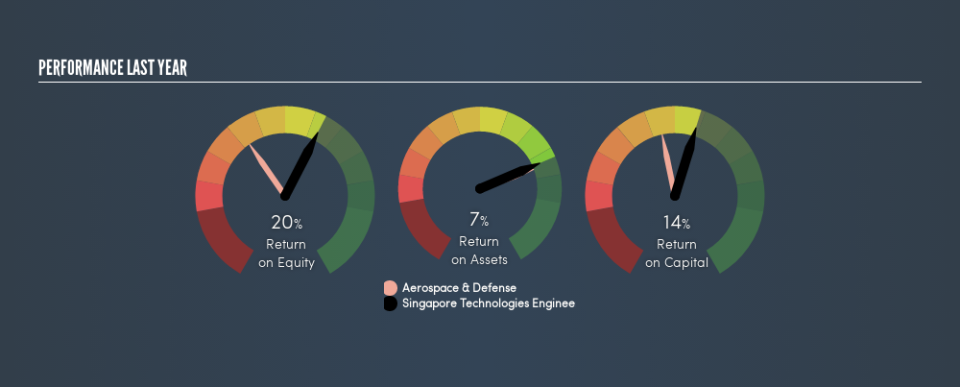Here’s What Singapore Technologies Engineering Ltd’s (SGX:S63) Return On Capital Can Tell Us

Want to participate in a short research study? Help shape the future of investing tools and you could win a $250 gift card!
Today we are going to look at Singapore Technologies Engineering Ltd (SGX:S63) to see whether it might be an attractive investment prospect. Specifically, we'll consider its Return On Capital Employed (ROCE), since that will give us an insight into how efficiently the business can generate profits from the capital it requires.
First, we'll go over how we calculate ROCE. Next, we'll compare it to others in its industry. Then we'll determine how its current liabilities are affecting its ROCE.
Understanding Return On Capital Employed (ROCE)
ROCE measures the 'return' (pre-tax profit) a company generates from capital employed in its business. Generally speaking a higher ROCE is better. Ultimately, it is a useful but imperfect metric. Renowned investment researcher Michael Mauboussin has suggested that a high ROCE can indicate that 'one dollar invested in the company generates value of more than one dollar'.
How Do You Calculate Return On Capital Employed?
Analysts use this formula to calculate return on capital employed:
Return on Capital Employed = Earnings Before Interest and Tax (EBIT) ÷ (Total Assets - Current Liabilities)
Or for Singapore Technologies Engineering:
0.14 = S$592m ÷ (S$8.0b - S$3.8b) (Based on the trailing twelve months to March 2019.)
So, Singapore Technologies Engineering has an ROCE of 14%.
View our latest analysis for Singapore Technologies Engineering
Does Singapore Technologies Engineering Have A Good ROCE?
One way to assess ROCE is to compare similar companies. It appears that Singapore Technologies Engineering's ROCE is fairly close to the Aerospace & Defense industry average of 13%. Regardless of where Singapore Technologies Engineering sits next to its industry, its ROCE in absolute terms appears satisfactory, and this company could be worth a closer look.
In our analysis, Singapore Technologies Engineering's ROCE appears to be 14%, compared to 3 years ago, when its ROCE was 11%. This makes us think about whether the company has been reinvesting shrewdly. The image below shows how Singapore Technologies Engineering's ROCE compares to its industry, and you can click it to see more detail on its past growth.
Remember that this metric is backwards looking - it shows what has happened in the past, and does not accurately predict the future. ROCE can be deceptive for cyclical businesses, as returns can look incredible in boom times, and terribly low in downturns. This is because ROCE only looks at one year, instead of considering returns across a whole cycle. Since the future is so important for investors, you should check out our free report on analyst forecasts for Singapore Technologies Engineering.
What Are Current Liabilities, And How Do They Affect Singapore Technologies Engineering's ROCE?
Current liabilities are short term bills and invoices that need to be paid in 12 months or less. The ROCE equation subtracts current liabilities from capital employed, so a company with a lot of current liabilities appears to have less capital employed, and a higher ROCE than otherwise. To counter this, investors can check if a company has high current liabilities relative to total assets.
Singapore Technologies Engineering has total liabilities of S$3.8b and total assets of S$8.0b. Therefore its current liabilities are equivalent to approximately 47% of its total assets. Singapore Technologies Engineering has a medium level of current liabilities, which would boost the ROCE.
Our Take On Singapore Technologies Engineering's ROCE
While its ROCE looks good, it's worth remembering that the current liabilities are making the business look better. There might be better investments than Singapore Technologies Engineering out there, but you will have to work hard to find them . These promising businesses with rapidly growing earnings might be right up your alley.
For those who like to find winning investments this free list of growing companies with recent insider purchasing, could be just the ticket.
We aim to bring you long-term focused research analysis driven by fundamental data. Note that our analysis may not factor in the latest price-sensitive company announcements or qualitative material.
If you spot an error that warrants correction, please contact the editor at editorial-team@simplywallst.com. This article by Simply Wall St is general in nature. It does not constitute a recommendation to buy or sell any stock, and does not take account of your objectives, or your financial situation. Simply Wall St has no position in the stocks mentioned. Thank you for reading.

